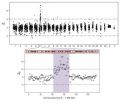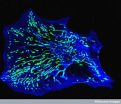(Press-News.org) A noninvasive, sequencing-based approach for detecting chromosomal abnormalities in the developing fetus is safer and more informative in some cases than traditional methods, according to a study published by Cell Press January 10th in The American Journal of Human Genetics. This method, which analyzes fetal DNA in the mother's blood, could provide women with a cost-effective way to find out whether their unborn baby will have major developmental problems without risking a miscarriage.
"Our study is the first to show that almost all the information that is available from an invasive procedure is also available noninvasively from a simple maternal blood draw," says senior study author Richard Rava of Verinata Health.
Metaphase karyotypes—pictures of chromosomes taken through the microscope—have traditionally been used to detect abnormalities associated with developmental delay, intellectual disability, congenital defects, and autism. Recently, a method called a chromosome microarray, which uses molecular probes to detect gains or losses of DNA segments within chromosomes, has been shown to provide more detailed information than a metaphase karyotype. But both of these approaches require invasive procedures that involve removing tissue from the placenta or inserting a needle into the amniotic sac to collect fluid. As a result, they increase the risk of infection and could harm the fetus during pregnancy.
Massively parallel sequencing (MPS) of fetal DNA in the mother's blood offers a safer alternative for the detection of chromosomal abnormalities across the fetal genome. But it has not been known whether MPS is as accurate as chromosome microarrays. In the new study, Rava and his team found that MPS was capable of detecting a variety of chromosomal abnormalities as accurately as chromosome microarrays.
"Such a noninvasive test could have clinical utility in the near future, particularly for women who either have a medical contraindication or lack access to an invasive procedure," Rava says. "This work suggests an exciting future path toward routine noninvasive detection of abnormalities in the entire fetal genome."
INFORMATION:
American Journal of Human Genetics, Srinivasan et al.: "Noninvasive Detection of Fetal Sub-Chromosome Abnormalities using Deep Sequencing of Maternal Plasma."
Study points to a safer, better test for chromosomal defects in the fetus
2013-01-10
ELSE PRESS RELEASES FROM THIS DATE:
Regulating single protein prompts fibroblasts to become neurons
2013-01-10
Repression of a single protein in ordinary fibroblasts is sufficient to directly convert the cells – abundantly found in connective tissues – into functional neurons. The findings, which could have far-reaching implications for the development of new treatments for neurodegenerative diseases like Huntington's, Parkinson's and Alzheimer's, will be published online in advance of the January 17 issue of the journal Cell.
In recent years, scientists have dramatically advanced the ability to induce pluripotent stem cells to become almost any type of cell, a major step in ...
Next steps in potential stem cell therapy for diabetes
2013-01-10
Type 1 and type 2 diabetes results when beta cells in the pancreas fail to produce enough insulin, the hormone that regulates blood sugar. One approach to treating diabetes is to stimulate regeneration of new beta cells.
There are currently two ways of generating endocrine cells (cell types, such as beta cells, that secrete hormones) from human embryonic stem cells, or hESCs: either generating the cells in vitro in culture or transplanting immature endocrine cell precursors into mice.
Researchers from the University of California, San Diego School of Medicine, collaborating ...
New insights into HIV vaccine will improve drug development
2013-01-10
DURHAM, N.C. – Four years ago, a potential HIV vaccine showed promise against the virus that causes AIDS, but it fell short of providing the broad protection necessary to stem the spread of disease.
Now researchers -- led by Duke Medicine and including team members from the National Institute of Allergy and Infectious Diseases of the National Institutes of Health, the U.S. Military HIV Research Program and the Thailand Ministry of Health -- have gained additional insights into the workings of the vaccine that help explain why it benefited a third of recipients and left ...
Cancer scientists determine mechanism of 1 of the most powerful tumor-suppressor proteins, Chd5
2013-01-10
Cold Spring Harbor, NY – A team of cancer researchers at Cold Spring Harbor Laboratory (CSHL) has solved the mystery of how one of the most powerful of the body's natural tumor-suppressing proteins, called Chd5, exerts its beneficial effects.
The findings, published online today in the journal Cell Reports, are important because Chd5 engages processes fundamental to cancer prevention. Conversely, when Chd5 is mutated or missing, an important door is opened to cancer initiation.
"For this reason, figuring out the mechanics of how Chd5 works to prevent cancer can directly ...
Researchers find causality in the eye of the beholder
2013-01-10
We rely on our visual system more heavily than previously thought in determining the causality of events. A team of researchers has shown that, in making judgments about causality, we don't always need to use cognitive reasoning. In some cases, our visual brain—the brain areas that process what the eyes sense—can make these judgments rapidly and automatically.
The study appears in the latest issue of the journal Current Biology.
"Our study reveals that causality can be computed at an early level in the visual system," said Martin Rolfs, who conducted much of the research ...
Study identifies infants at highest risk of death from pertussis
2013-01-10
ARLINGTON, VA, January 10, 2013—A study released today from the upcoming issue of the Journal of the Pediatric Infectious Diseases Society (JPIDS) found that taking early and repeated white blood cell counts (WBC) is critical in determining whether infants have pertussis and which of those children are at highest risk of death from the disease.
In 2010, California reported its highest pertussis rates in 60 years. Murray, et al.'s retrospective study used medical records from five Southern California Pediatric Intensive Care Units between September 2009 and June 2011. ...
Haiti can quell cholera without vaccinating most people, UF researchers estimate
2013-01-10
GAINESVILLE, Fla. --- Cholera could be contained in Haiti by vaccinating less than half the population, University of Florida researchers suggest in a paper to be published Thursday in the journal Scientific Reports.
The work places UF's Emerging Pathogens Institute in the pro-vaccination camp in an ongoing international debate over how best to contain the two-year-old epidemic that has claimed thousands of lives.
The Centers for Disease Control and Prevention has been skeptical about the effectiveness of vaccination against cholera in this setting. It has instead ...
Teenagers with a low muscular strength have a higher risk of dying early form heart disease
2013-01-10
Teenagers with a low muscular strength have a 30% higher risk of committing suicide before the age of 55 years, and a 65% higher risk of developing psychiatric diseases such as depression of schizophrenia. In addition, a low muscular strength during childhood and adolescence is a strong predictor of early death –i.e. before 55 years of age– from cardiovascular disease. A low muscular strength is as powerful a predictor as obesity and high blood pressure.
This was the conclusion drawn in a study recently published in the Medical Journal –a world-leading medical journal– ...
Declining access to electroconvulsive therapy: A clinical choice or an economic one?
2013-01-10
Philadelphia, PA, January 10, 2013 – Horrific images from One Flew Over the Cuckoo's Nest notwithstanding, modern electroconvulsive therapy (ECT) remains one of the safest and most effective antidepressant treatments, particularly for patients who do not tolerate antidepressant medications or depression symptoms that have failed to respond to antidepressant medications.
Since its introduction in the 1930s, ECT has evolved into a more refined, but more expensive and extensively regulated clinical procedure. Each treatment involves the assembly of a multidisciplinary clinical ...
Study shows that human hearts generate new cells after birth
2013-01-10
Boston, Mass. — Researchers at Boston Children's Hospital have found, for the first time that young humans (infants, children and adolescents) are capable of generating new heart muscle cells. These findings refute the long-held belief that the human heart grows after birth exclusively by enlargement of existing cells, and raise the possibility that scientists could stimulate production of new cells to repair injured hearts.
Findings of the study, "Cardiomyocyte proliferation contributes to post-natal heart growth in young humans," were published in Proceedings of the ...


